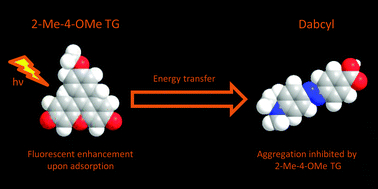Fluorescence enhancement of a fluorescein derivative upon adsorption on cellulose†
Abstract
9-[1-(2-Methyl-4-methoxyphenyl)]-6-hydroxy-3H-xanthen-3-one (2-Me-4-OMe TG) is a fluorescein derivative dye whose photophysical properties show a remarkable pH dependence. In aqueous solution the fluorescence quantum yield (Φf) of its anionic species is nearly a hundred times higher than that of its neutral species. Such a large difference in Φf makes 2-Me-4-OMe TG useful as an “on–off” pH indicator. Here we report that adsorption on the surface of microcrystalline cellulose exerts a profound effect upon the photophysical properties of 2-Me-4-OMe TG. On the solid only the dye neutral species is observed and its Φf is 0.31 ± 0.10, which is approximately thirty times higher than the value found for the neutral species in aqueous solution (Φf = 0.01). 2-Me-4-OMe TG and Dabcyl (DB) were co-adsorbed on the surface of microcrystalline cellulose to study the transfer of excitation energy from the former to the latter. In the absence of the dye, the formation of DB aggregates is observed at concentrations greater than 0.34 μmol per gram of cellulose, while in the presence of 2-Me-4-OMe TG the formation of DB aggregates is thoroughly inhibited. The quenching of fluorescence of 2-Me-4-OMe TG by DB reaches efficiencies as high as 90% for the most concentrated samples.


 Please wait while we load your content...
Please wait while we load your content...